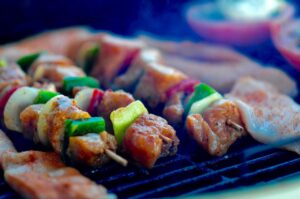A Traeger temperature swing is defined as a sudden change in the internal temperature of your grill. This can happen for a variety of reasons, including:
- A change in your environment (e.g., if you move it to another room)
- Opening and closing the lid too often or not enough
- Cooking at higher temperatures than usual
How to Prevent Traeger Temperature Swings
To prevent temperature swings, you’ll need to know how to adjust the grill’s temperature controller. The first step is finding out what type of controller your Traeger uses–there are two main types:
- Analog dials (the older models)
- Digital displays with buttons
How to Troubleshoot Traeger Temperature Swings
Check the temperature probe
The first thing you should do when troubleshooting a Traeger temperature swing is check the temperature probe.
The temperature probe is what measures and transmits your grill’s internal temperature, so if it’s faulty or broken, it could be causing your problems.
If you’re having trouble finding it on your grill, look for a small black box with wires coming out of it near the top surface of your smoker (it will be attached to one side).
How to Adjust Traeger Temperature Swings
- Adjusting the temperature controller
- Adjusting the grill’s temperature
- Adjusting the fuel source
Common Causes of Traeger Temperature Swings
- Grill insulation: If your grill is not insulated, it will lose heat quickly. This is especially true if you live in a warm climate or use your smoker outside.
- Temperature controller: The temperature controller can be set to maintain a specific temperature; however, if it’s not working properly or calibrated correctly, the temperature may fluctuate too much.
- Fuel source: A propane tank will only last so long before needing to be refilled and replaced with another full tank of propane gas (or other fuel source).
How to Avoid Traeger Temperature Swings
The first step to avoiding temperature swings is to maintain proper grill temperature. If you’re using a Traeger pellet smoker, this means keeping an eye on your grill’s controller and making adjustments as needed.
If your Traeger is electric or gas, it’s important to keep the flame consistent throughout cooking if one side of the grill gets hotter than another for some reason (like if there’s some kind of obstruction in front), turn down that side until it matches up with its counterpart.
Another way to avoid temperature swings is by cleaning out your grill regularly; ash buildup can cause uneven heating and make it harder for heat from coals or flames to reach all parts of your food evenly
Tips for Managing Traeger Temperature Swings
- Adjust the temperature controller. If you’re having trouble reaching a specific temperature, try adjusting the controller and re-calibrating it to see if that helps.
- Monitor the grill’s temperature. If your Traeger is running hot or cold, check out our guide on how to monitor grill temperatures so that you can adjust accordingly!
- Clean regularly with an appropriate cleaner like this one from Traeger Grills.
Troubleshooting Traeger Temperature Swings
When you are experiencing problems with temperature swings, there are a few things to check.
First, make sure that your temperature probe is working correctly. If it’s not, then your grill may be running too hot or too cold. If this is the case, replace the probe with a new one and see if that fixes it.
Next, check that there isn’t any insulation missing from around your grill’s firebox this can cause similar issues as well!
Finally, make sure that none of your wires have come loose or disconnected anywhere along their path from where they enter into the smoker through to where they connect with their respective components inside.
Common Questions about Traeger Temperature Swings
In this section, we’ll answer some of the most common questions about Traeger temperature swings.
- What causes Traeger temperature swings?
- What are the different types of Traeger temperature swings?
- How do you identify a Traeger temperature swing in your grill?
Conclusion
The Traeger temperature swings are a common problem, but they are also easy to manage. The best way to prevent them is by keeping an eye on your grill and making sure it’s running at its optimal temperature.
If you do find yourself with a Traeger that’s running too hot or too cold, there are some simple things you can do to help bring it back into balance.
If your grill has been running too hot for an extended period of time (more than 30 minutes), try opening up the lid and letting some heat escape before closing again.
This will allow air into the chamber so that more smoke can be produced by burning wood chips or pellets in order to bring down temperatures quickly.
Alternatively, if your grill has been running too cold for an extended period of time (more than 30 minutes).
Try closing off vents around doors and drawers on top as well as any vents under cabinets where heat might escape from within these areas before opening up again later once temperatures have dropped below optimum levels again.
